
Ephedra distachya is a shrub in the family Ephedraceae that stands about 25 cm to 50 cm high. The shrub grows in many parts of the world, including southern and central Europe and western and central Asia. Its local names include somlatha.

Ephedrine is a central nervous system (CNS) stimulant that is often used to prevent low blood pressure during anesthesia. It has also been used for asthma, narcolepsy, and obesity but is not the preferred treatment. It is of unclear benefit in nasal congestion. It can be taken by mouth or by injection into a muscle, vein, or just under the skin. Onset with intravenous use is fast, while injection into a muscle can take 20 minutes, and by mouth can take an hour for effect. When given by injection it lasts about an hour and when taken by mouth it can last up to four hours.
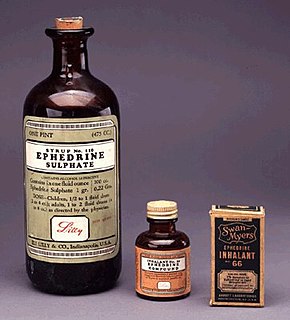
Ephedra is a medicinal preparation from the plant Ephedra sinica. Several additional species belonging to the genus Ephedra have traditionally been used for a variety of medicinal purposes, and are a possible candidate for the soma plant of Indo-Iranian religion. It has been used in traditional Chinese medicine, in which it is referred to as Ma Huang, for more than 2,000 years. Native Americans and Mormon pioneers drank a tea brewed from other Ephedra species, called "Mormon tea" and "Indian tea".
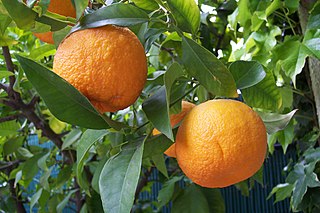
Bitter orange, Seville orange, bigarade orange, or marmalade orange is the citrus tree Citrus × aurantium and its fruit. It is native to Southeast Asia and has been spread by humans to many parts of the world. It is probably a cross between the pomelo, Citrus maxima, and the mandarin orange, Citrus reticulata.

D-norpseudoephedrine, also known as cathine and (+)-norpseudoephedrine, is a psychoactive drug of the phenethylamine and amphetamine chemical classes which acts as a stimulant. Along with cathinone, it is found naturally in Catha edulis (khat), and contributes to its overall effects. It has approximately 7-10% the potency of amphetamine.
The ECA stack is a drug combination used in weight loss and as a stimulant. ECA is an initialism for ephedrine, caffeine, and aspirin, with variants of it including the EC stack, which removes the aspirin for those who can not tolerate it. Dietary supplements based on or including elements of ECA were popular through the 1990s and early 2000s, but the marketing of ephedra- or ephedrine-containing stimulant combinations for weight loss and bodybuilding is now restricted or illegal in the United States, Canada and Netherlands due to reports of heart attack, stroke, and death associated with these supplements.

Ephedra is a genus of gymnosperm shrubs. The various species of Ephedra are widespread in many arid regions of the world, ranging across southwestern North America, southern Europe, northern Africa, southwest and central Asia, northern China and western South America. It is the only extant genus in its family, Ephedraceae, and order, Ephedrales, and one of the three living members of the division Gnetophyta alongside Gnetum and Welwitschia.
A strobilus is a structure present on many land plant species consisting of sporangia-bearing structures densely aggregated along a stem. Strobili are often called cones, but some botanists restrict the use of the term cone to the woody seed strobili of conifers. Strobili are characterized by a central axis surrounded by spirally arranged or decussate structures that may be modified leaves or modified stems.

Ephedra sinica is a species of Ephedra native to Mongolia, Russia, and northeastern China.
Steven Scott Bechler was an American professional baseball pitcher, who played in Major League Baseball (MLB) for the Baltimore Orioles.
Metabolife International, Inc. was a multi-level marketing company based in San Diego, California which manufactured dietary supplements. Metabolife's best-selling product, an ephedra supplement called Metabolife 356, once generated hundreds of millions of dollars in annual sales. However, Metabolife 356 and other ephedra-containing supplements were linked to thousands of serious adverse events, including deaths, which caused the U.S. Food and Drug Administration (FDA) to ban the sale of ephedra-containing dietary supplements in 2004.

The 2003 Baltimore Orioles season involved the Orioles finishing 4th in the American League East with a record of 71 wins and 91 losses.

Ephedra californica is a species of Ephedra, known by the common names California jointfir, California ephedra, desert tea, Mormon tea, and cañatillo.
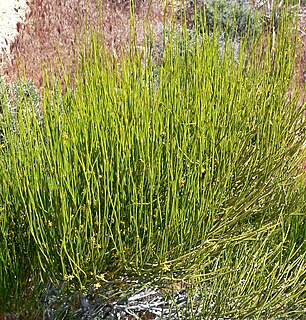
Ephedra viridis, known by the common names green Mormon tea, green ephedra, and Indian tea, is a species of Ephedra. It is indigenous to the Western United States, where it is a member of varied scrub, woodland, desert, and open habitats. It grows at 900–2,300 metres (3,000–7,500 ft) elevations.

Ephedra torreyana, with common names Torrey's jointfir or Torrey's Mormon tea, is a species of Ephedra that is native to the deserts and scrublands of the Southwestern United States and to the State of Chihuahua and northern Mexico.
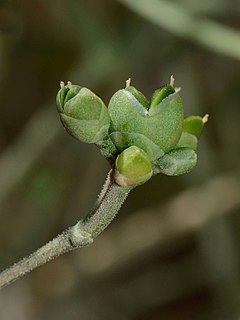
Ephedra foliata is a species of gymnosperm in the Ephedraceae family. It is referred to by the common name shrubby horsetail. It is native to North Africa, and Southwest Asia, from Morocco and Mauritania east to Turkmenistan, Pakistan, and Punjab State in India.
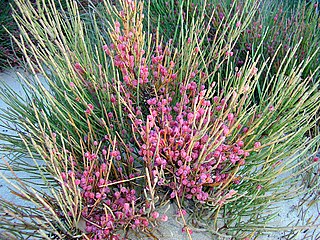
Ephedra fragilis, commonly named the joint pine, is a species of Ephedra that is native to the western Mediterranean region of southern Europe and Northern Africa, and from Madeira and the Canary Islands in the Atlantic.
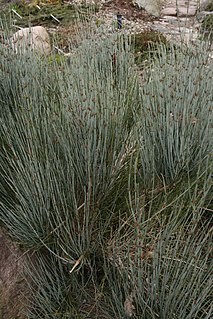
Ephedra intermedia, with the Chinese common name of Zhong Ma Huang, is a species of Ephedra that is native to Siberia, Central Asia, Iran, Afghanistan, Pakistan, the western Himalayas, Tibet, Mongolia, and China.

Ephedra nevadensis, commonly known as Nevada ephedra, gray ephedra, Mormon tea and Nevada jointfir, is a species of gymnosperm native to dry areas of western North America.














